O nce Upon A Great Time Ago, on the 13th of April 2002, something neat happened. Captain David Brown, author of Last Log of the Titanic, suggested on Encyclopedia Titanica that those with access to the Toledo area should flock there for a gathering. Yes, a gathering to celebrate the 90th anniversary of the sinking of the unsinkable Titanic. The event would take place aboard the freighter Willis B. Boyer, docked in downtown Toledo. If you read the Boyer page you would know that Boyer was launched within months of Titanic, making them nearly the same age. Similar construction techniques were employed and upon launch, both vessels were the largest of their breed. And here it sat on the Maumee River, waiting for us to board! Sure, those who did their thing in Orlando had a nice recreation of the staircase, but they didn't have working engine-order telegraphs ("Chadburns") inside a fully riveted hull! Ha! We had the real stuff!
R MS Titanic sank on her maiden voyage in the wee morning hours of 15 April 1912. Our anniversary shindig was on 13 April 2002. No, we weren't exactly on the dot, but no one's perfect. Speaking of which, what's that on your shirt?
T itanic Toledo was slated to begin at 2:30 in the afternoon, but for good measure I showed up around 2-ish. The two captains were already there, Dave Brown and Erik Wood. At 2:30, the tour began.
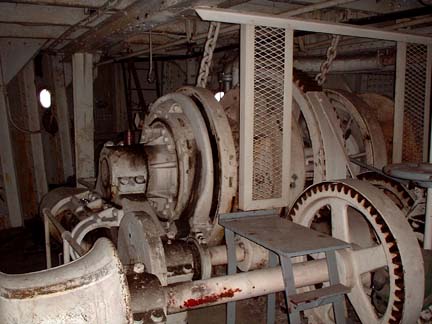 |
The windlass gear below deck, which handles the anchor chains. Compare with the view on the Boyer page. Here you're seeing it from behind. Notice the hull coming to a point forward of the machinery.
|
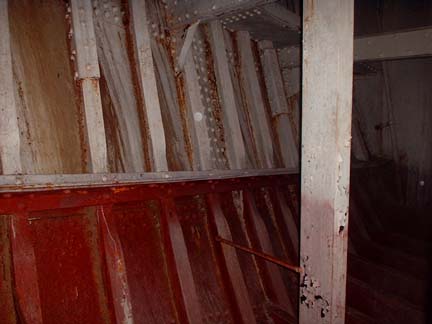 |
The forepeak tank, standing on the keel. This is the starboard side, below the waterline: In effect, Ground Zero on Titanic. This is where the ice damage occurred. Looking astern is the collision bulkhead. That paint is the original, over ninety years old!
|
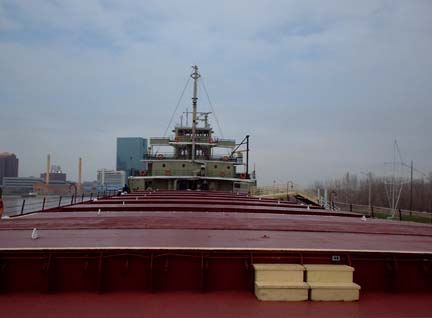 |
Back on deck looking across the cargo hatches at the forword superstructure.
The enormous star off to the right is part of International Park's holiday lights display, parts of which remain standing all year round.
|
 |
We broke for dinner and I took some time to photograph the vessel's exterior. A view down the side of the ship towards the bow. Note the mooring lines holding her to shore.
|
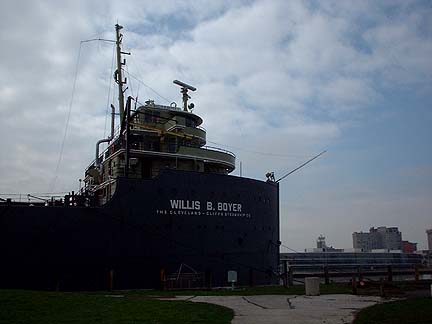 |
The forecastle and forword superstructure area. The radar is obviously not part of her original design.
|
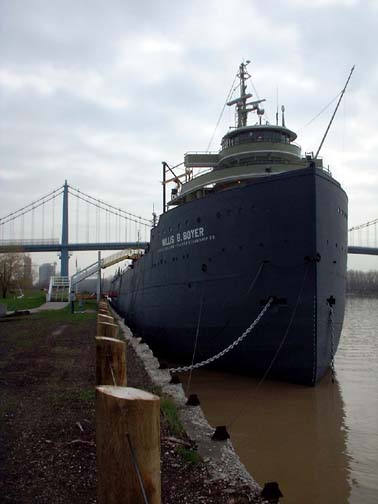 |
Boyer as she would have appeared to dockworkers while loading iron ore. Notice how high she rides in the water: With a full load of ore, she would be laden almost to her anchor hawseholes.
|
 |
A glance up her side, revealing her name.
|
 |
Another attempt at photographing her name. A vessel's name is a very noble thing. It represents that ship's character.
|
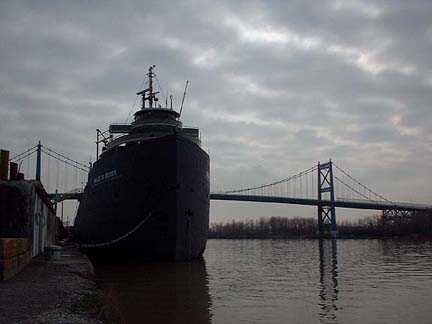 |
The Cleveland Cliffs bulk ore freighter SS Willis B. Boyer.
Do you like this photo? I did, so I made some desktop wallpaper you may enjoy:
800 x 600 resolution
1024 x 768 resolution
|
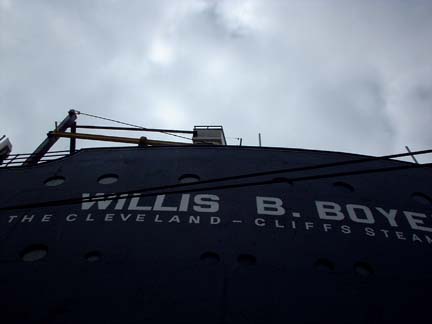 |
Hopping down to the lower level of the quay allowed this view, practically straight up the vessel's towering side. I was stepping between ropes with full knowledge of the danger.
Safety tip: Never step between the lines holding a vessel to shore. It's a very good way to lose a leg, if you're lucky.
|
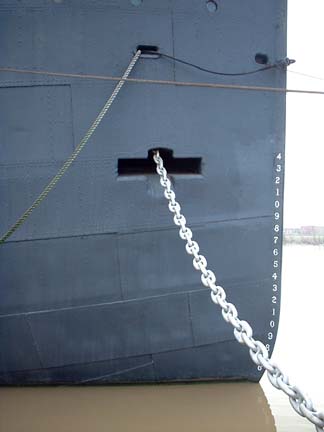 |
The port anchor hawsehole. Note the draft numbers. The zeros represent her loading levels waterlines; how low she would ride with cargo loaded. At this point, Dan Cherry arrived and we met the others at Cousinos for dinner.
|
Following dinner, the visitor tour of Boyer for Titanic Toledo began. Quite a good many people showed up for the event. In all, it was a very good turnout, with proceeds going towards the restoration of Boyer.
 |
This is taken from the engineering catwalk near the entrance, looking straight down. That yellow object at the bottom of the ship is the propeller shaft. The bottom of the picture is equivalent to aft.
|
 |
Dan Cherry and I had some discussion about taffrail logs (also "patent log") not very long before this meeting. These "logs" would be hung from the stern of a ship, recording the distance traveled. In effect, a marine odometer. Pictured is the distance gauge.
Dan had to leave early, and I was surprised to find this in a display case. So I took a picture, because those last longer.
|
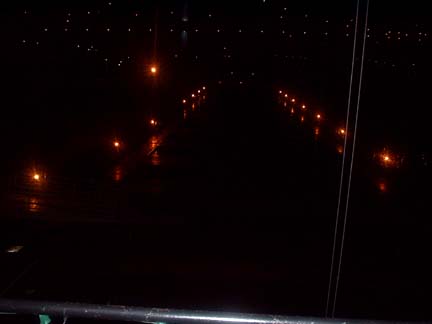 |
Looking aft from the forword superstructure at the deck lamps that came on after dark.
|
 |
Inside the pilothouse at night.
When the ship was in service, all lights in the pilothouse would be extinguished after dark. This is to preserve the night vision of the personnel on duty.
Note the "Titanic Toledo" information signs.
|
 |
Captain Erik Wood during the lifeboat demonstration.
Boyer's boat davits were developed by Axel Welin and Company. Welin davits of a different design were fitted on Titanic and her sisters.
|
|

